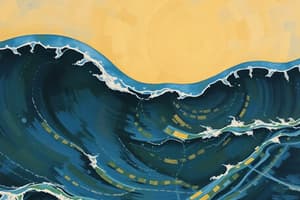Podcast
Questions and Answers
What is the lithosphere primarily composed of?
What is the lithosphere primarily composed of?
- Atmospheric gases
- Molten iron core
- Solid outer part of the earth (correct)
- Liquid magma
What does the plate tectonics theory explain?
What does the plate tectonics theory explain?
- Movement of ocean currents
- Weather patterns and climate change
- Movement of geologic plates causing earthquakes (correct)
- Formation of fossil fuels
What are seismic waves?
What are seismic waves?
- Waves that generate ocean tides
- Waves that travel through the atmosphere only
- Sound waves produced by volcanic eruptions
- Energy waves that move outward from an earthquake's focus (correct)
What is the focus of an earthquake?
What is the focus of an earthquake?
Which of the following is a type of surface wave?
Which of the following is a type of surface wave?
Where do the majority of earthquakes occur?
Where do the majority of earthquakes occur?
Which of the following statements is accurate regarding active volcanoes?
Which of the following statements is accurate regarding active volcanoes?
What is the significance of the Pacific Ring of Fire?
What is the significance of the Pacific Ring of Fire?
How do earthquake epicenters compare to volcanic locations?
How do earthquake epicenters compare to volcanic locations?
Which statement about earthquake distribution is true?
Which statement about earthquake distribution is true?
What is the travel speed of Primary (P) waves?
What is the travel speed of Primary (P) waves?
Which of the following statements is true about Secondary (S) waves?
Which of the following statements is true about Secondary (S) waves?
Which characteristic is shared by both P and S waves?
Which characteristic is shared by both P and S waves?
What is a primary effect of Secondary (S) waves compared to Primary (P) waves?
What is a primary effect of Secondary (S) waves compared to Primary (P) waves?
What describes the amplitude and spacing of normal background noise from seismic waves?
What describes the amplitude and spacing of normal background noise from seismic waves?
In which type of regions are mountain ranges typically found?
In which type of regions are mountain ranges typically found?
What phenomenon is frequently associated with areas containing mountain ranges?
What phenomenon is frequently associated with areas containing mountain ranges?
How does the separation of the Earth's lithosphere affect the collection of information?
How does the separation of the Earth's lithosphere affect the collection of information?
Which of the following is a common result of high tectonic activity in areas with mountain ranges?
Which of the following is a common result of high tectonic activity in areas with mountain ranges?
What is typically true about regions with frequent volcanic activity?
What is typically true about regions with frequent volcanic activity?
Flashcards are hidden until you start studying
Study Notes
Seismic Waves
-
P-waves (Primary waves)
- Travel through both liquids and solids.
- Move materials by pushing and pulling during their motion.
- Speed of approximately 8 km/s.
- First type of wave felt during an earthquake.
-
S-waves (Secondary waves)
- Travel only through solids.
- Cause rocks to vibrate up and down as well as sideways.
- Travel at about 4.5 km/s.
- Typically result in more significant damage to buildings compared to P-waves.
-
Both P and S-waves
- Originate from the same focus during an earthquake.
- Initiate simultaneously.
- Can be detected at the Earth's surface.
Seismic Wave Characteristics
- Normal Background Waves
- P-waves exhibit low amplitude with one crest every 2-10 seconds.
- S-waves show higher amplitude dynamics with irregular spacing of about 40 seconds between crests.
- Regular spacing in S-wave signals detected at a rate of one crest every 20 seconds.
Earth's Structure
- Lithosphere
- Comprises the solid outer layer of the Earth.
- Includes the brittle upper crust, the outermost layer of the Earth's structure.
Tectonic Activity
-
Tectonic Plates
- Massive slabs of solid rock forming the Earth's lithosphere.
- Movement of these plates leads to geological activities including earthquakes and volcanoes.
-
Plate Tectonics Theory
- Explains the dynamics of moving geological plates responsible for mountain building, volcanic activity, and seismic events.
-
Focus
- The point within the Earth's interior where an earthquake's energy is released, leading to seismic waves.
Seismic Wave Types
- Body Waves
- Includes both P-waves and S-waves.
- Surface Waves
- Comprises Rayleigh waves and Love waves.
Earthquake and Volcano Distribution
-
Earthquake Epicenters
- Predominantly located along tectonic plate boundaries and fault lines.
- Regions remote from fault lines experience fewer earthquakes.
- Earthquakes primarily occur on land but can affect off-shore areas based on tectonic movements.
-
Volcano Distribution
- Mostly clustered around the edges of tectonic plates, particularly along the Pacific Ring of Fire.
- Volcanoes can be found in both land and underwater areas.
-
Mountain Ranges
- Commonly found in regions with high tectonic activity.
- Correlate with areas of frequent earthquakes and volcanic eruptions due to the movement of the Earth's lithosphere.
Studying That Suits You
Use AI to generate personalized quizzes and flashcards to suit your learning preferences.



